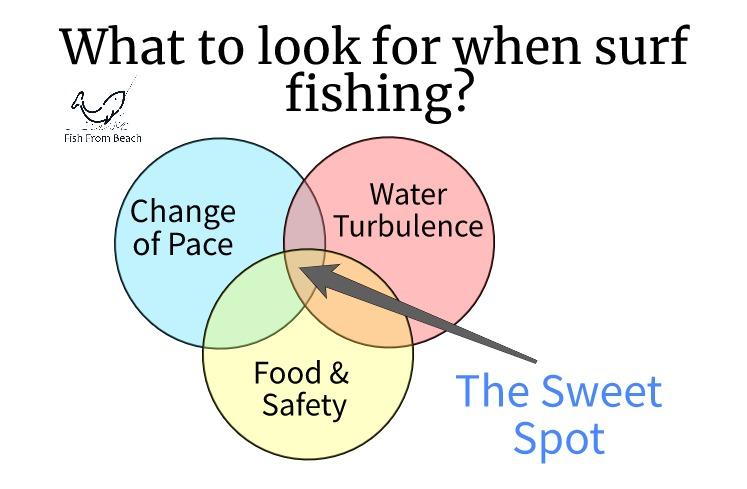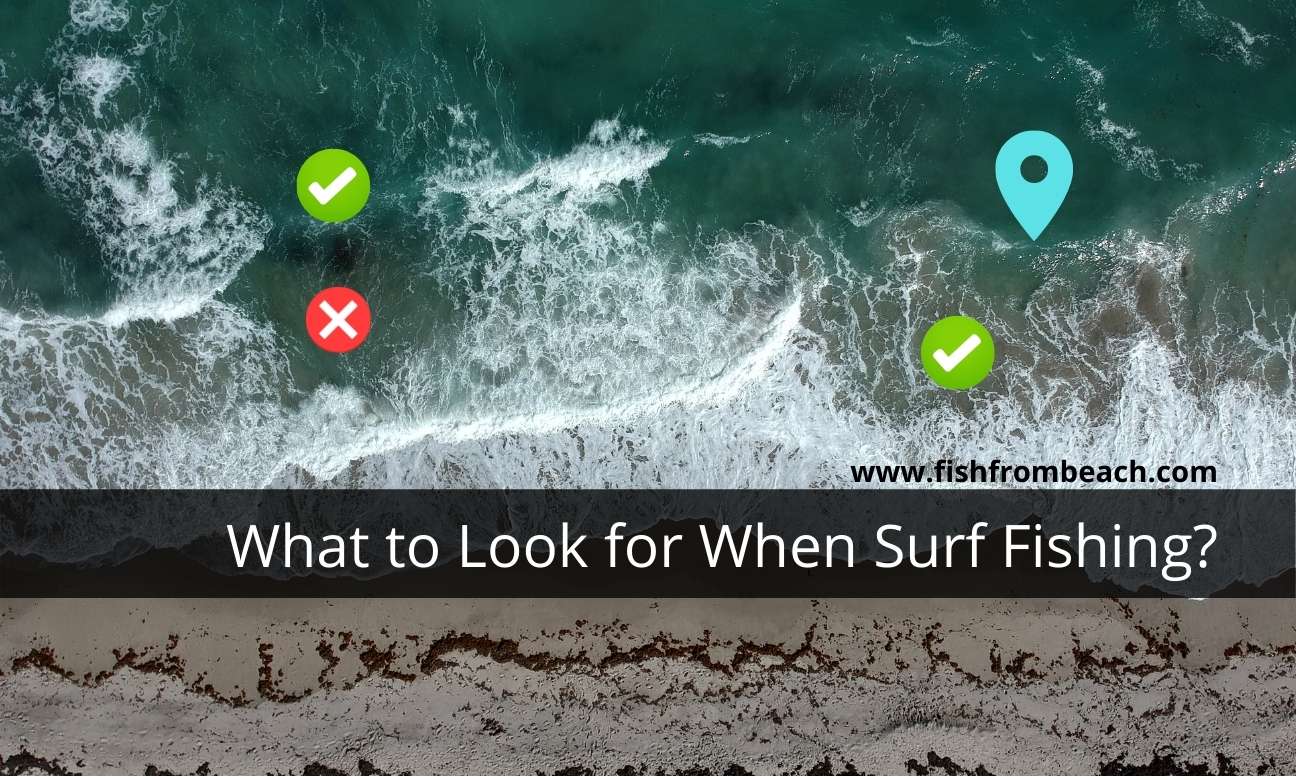
When it comes to surf fishing, if you don’t know what to look for in terms of the spots to target and the areas to cast into, you are definitely leaving a lot of fish on the table.
Fish in general are extremely cautious creatures and will only hold in areas where they feel safe to hide and feed. Therefore, unless you can identify these spots and deploy your baits around them, don’t expect to have a satisfactory catches count.
That’s what we will talk about in this article.
In the following paragraphs, we will discuss the distinct patterns to look for when surf fishing and learn about which areas are most likely to bring bites.
What to look for when surf fishing?
We’ll give a list of what to look for when surf fishing later on, but before that, let’s focus on what makes these spots good and rewarding.
I mean, before we get into the exact places to deploy baits, we first need to understand why those places bring bites in the first place. In other words, why do fish prefer to hang out in these areas more than in others? Fair enough? Let’s go.
As a general rule, you will be most successful if you can deploy your bait in areas that have at least one of the three following criteria:
1- Water turbulence
Water turbulence is good for two reasons. First, it stirs up the nutrients and tiny life-forms hidden under the sand and between the piles of rocks and vegetables. Second, it makes it hard for small species to navigate, which makes them easy prey for larger predators.
Turbulence also makes the water muddy and colorful, and that provides small fish with a safe cover to hide from predators and feed comfortably.
In turn, the larger fish also exploit the murky waters as a cover to surprise and trick unwary prey.
All this explains why a choppy surf is generally more rewarding for surfcasters than a calm, no-swell surf.
The turbulence of water kind of activates the entire food chain and encourages all the creatures under the water to get a meal.
As I said, the small species first leave the shelter and compete for the food exposed to them by the turbulence. In turn, predatory fish approach the shore because they know that prey is out of cover looking for food, and also easy to hunt because the strong currents prevent them from swimming properly.
2- Change of pace
This is what to look for if you want to have better odds with sizable fish.
What I mean by “change of pace” are areas where the speed of water suddenly goes up or down.
This quick change disorients small fish and makes them much easier to hunt.
In other words, when a school of prey passes through an area where the water speed is rising or falling, some fish get isolated and therefore more exposed to the hungry predators lurking in the corners.
So opportunistically, big game fish prefer to hide in similar places and wait for the prey to swim by. This gives them easy access to food without consuming too much energy in the water columns that prey find easy to navigate.
3- Food and safety
Fish, especially those we encounter in the surf, are in constant search of a place where they can find two elements:
Food: Easy access to an abundant source of nutrients.
Safety: A safe place where they can hide and escape predators, and where they can breed comfortably and satisfy their biological needs.
Fish will therefore always be looking for these two elements. This explains why some species keep migrating throughout the year and never settle in the same place all the time. The reason is that as they grow older their needs and standards for food and safety change and therefore decide to move elsewhere where they can meet the new standards.
It’s very important to keep that in mind when surf fishing.
Before casting the line, look for areas where you think there is more food or safety for the fish than others. We’ll give a few examples later, but spotting the beach at low tide is a good practice that can help you easily identify these areas. Take notes and come back at high tide. Chances are you will find some good catches there holding and waiting for your offer.
So these were the 3 elements to look for when surf fishing. Water turbulence, change of pace, and food & safety.
Now, of course, it would be perfect if you could find all these elements together in one place. That’s the dream spot for any surf angler.
However, keep in mind that you only need one factor to catch fish from shore. So don’t be perfectionist trying to find a spot where the 3 characteristics meet.
Keep your expectations low and be happy with whatever you find within your casting range.
In the following sections, we will discuss some examples that you can find in the surf and that incorporate one or more of the above criteria. This is where things get interesting. So keep reading 😉
7 spots to look for
1- The sandbars
The sandbars are the easiest to find when surf fishing.
As their name suggests, sandbars (also called sandbanks) are bars of sand or coarse sediment that form underwater and run parallel to the shore. They are like bumps that result from the continuous wave action and may change in structure over time depending on the recent activity in the surf zone.
In general, regardless of which beach you fish, you should be able to find 2-3 sandbars separating the shore from the open sea. How to identify them? Easy. Just look where the waves start to crash and rollover. In other words, look where the foamy white waters begin to form.
The white water indicates that there is a bump in the underwater terrain which forces the waves to raise and crash.
Now, based on this description, can you guess what makes sandbars attractive to fish?
You guessed right. Fish prefer to stay where the waves crash because the water turbulence stirs up and exposes the nutrients on the seabed, providing them with a good food supply.
Also, the turbulence around the sandbars makes it hard for small and medium-size fish to swim and navigate. As a result, predators can chase them easily and without consuming too much energy.
So, as you can see, both large and small fish like to hold and concentrate around the sand bars. They are therefore a promising mark to look for when surf fishing.
Now when targeting the sandbars, aim for the edges (preferably the sea-side edge) and try to avoid the top. The water may be too shallow at the top, which makes it unsafe for most species.
One last thing about the sandbars is that the way waves break reveals a lot about the nature of the submerged sandbars.
Let me explain.
When the white water softly sprays over a long distance, it means that the underwater bump is gradual and progressive.
This is great for surf fishing. Why? Because it engenders more water turbulence and therefore allows fish to hold on a wider surface, which improves the odds of catching something.
On the flip side, when the cut-off between the white and the blue water is acute and precise, it means that it’s a sharp bump underneath.
Here, you need to be more accurate when throwing your line because it will be more difficult to deploy the bait near the sandbars.
2- The troughs
The troughs (also called the sloughs or hollows) are the deep and clear waters separating 2 sandbars.
How to spot them? Look for dark-colored waters in the seaward or the shoreward of the sandbard. The dark color indicates that there is deep water below, and that is exactly what we mean by a trough.
As a general rule, you should only aim for the trough if you are only interested in large fish and want to filter the small species out.
As we said, the water between the sandbanks is deep and clear, making it a dangerous place for small and medium-sized fish. Why? Well, simply because it exposes them and makes them more visible to larger predatory fish.
As a result, small fish rarely venture inside the trough and prefer to stay around the sandbars where water turbulence makes them less visible to predators.
So casting your bait into the trough is the way to go if you want to prevent small fish from stealing your offer.
In turn, the clear waters inside the troughs make predators go short of cover and therefore reduce their chances of surprising their prey.
Thus, large fish rarely use the troughs to feed or hunt. Instead, they use it as a channel to approach the sandbars where prey fish hold or to enter/leave the rip current. That said, they will still take your bait if they find it inside the trough. In fact, they may even compete for it because of the lack of food there.
3- The rip channels
The rip channels are simply the openings breaking the sandbars. In order to identify them, simply look where the waves never break or rollover.
As you observe the discontinuity in the waves, you will notice a channel-shaped passage passing between the sandbars and heading towards the sea. That’s what we call a rip channel.
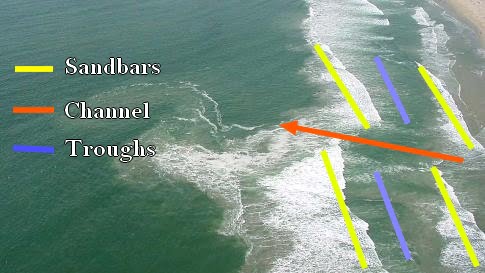
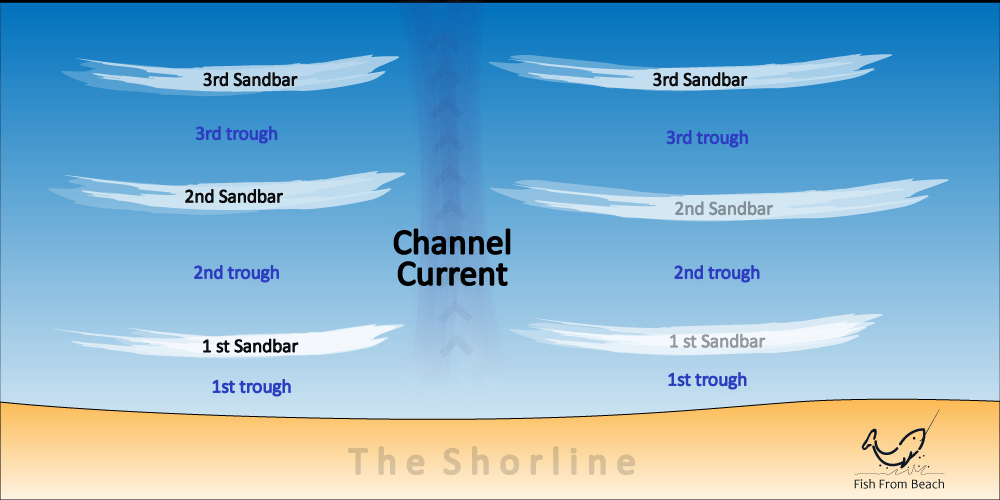
These channels are good targets for surf fishermen, especially when aiming for large predatory fish. Why? Because inside the channels there are currents (called rip currents) heading offshore and carrying all the nutrients, mollusks, crabs, shellfish, and food elements found on the near-shore structures.
So when looking for food, the large fish living offshore use the rip channels to approach the shoreline and feed on the nutrients carried by the rip currents.
That is why you should target the channels when surf fishing. Leaving your offer there improves your odds with large fish as your bait may be the first food item they encounter on their way to shore.
What I like the most when targeting the channels is that most bites there come from sizeable fish. The small species rarely venture out to the channel.
With all the predators navigating there, it is certainly not a safe place for creatures at the bottom of the food chain.
4- The cut-offs
The cuts are simply the lines that separate the sandbars from the channels.
If you’ve followed this article this far, you should be able to identify the cut-offs quite easily.
All you have to do is to look for discontinuities in the white waters that result from the breaking waves.
If the discontinuity is wide and horizontal, it means that there is a deep channel cutting through the sandbars. The cut-offs are therefore the two extremities of the channel where the sandbars begin.
These are glorious spots to look for when surf fishing because they allow you to target both large and small fish.
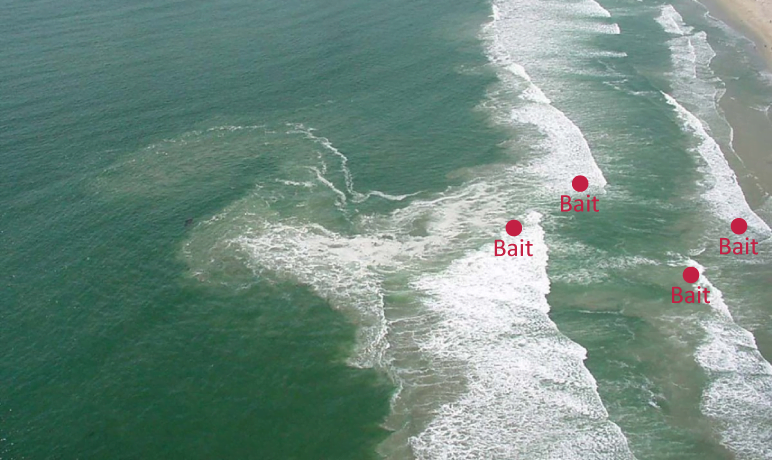
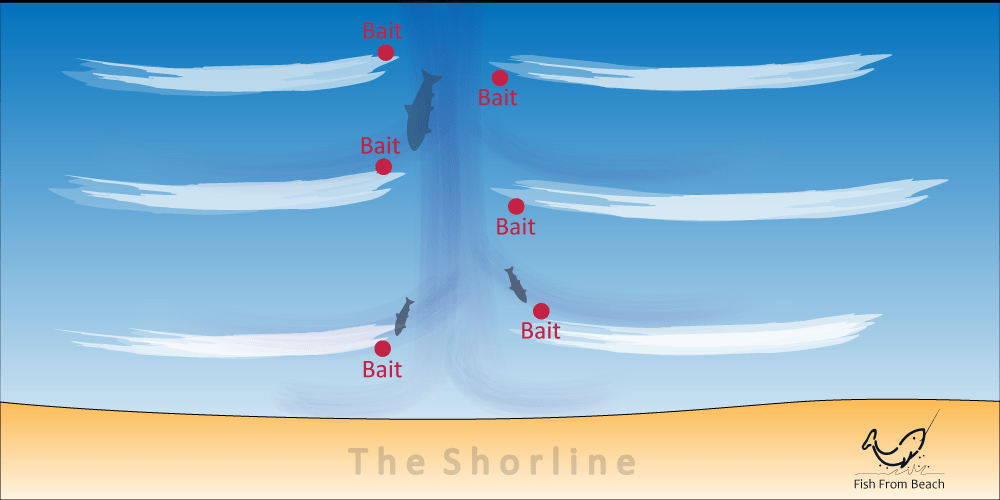
As we said, predatory fish hanging in the channels use the cut-offs to get into the troughs and approach the prey concentrating around the sandbars. So deploying baits in these entry points can help you get more catches, both from the predators in search of prey, or the small and medium-size species lurking on the sandbars.
5- The holes
The holes are zones in the seabed that are deeper than others.
They are like sand pockets where the underwater terrain suddenly gets deeper and then goes back to normal depth.
You should be able to identify certain holes wherever you fish, but sometimes it is difficult to find them, especially at high tide when the sea level goes up.
As a rule of thumb, the best way to find the holes is to look for areas on the water’s surface with darker green/blue color.
Another indicator of holes is the areas where the white water disappears and the waves do not break.
So start observing how the waves break in the surf zone. If you notice that they always stop crumbling over a particular area, that spot could be a hole and therefore a good place to target.
What makes the holes perfect for surf fishing is that they are often characterized by a sudden drop in the current pace, which as we said allows game fish to easily hunt disoriented prey.
Also, small species like to hold inside the holes so they can take a break from the heavy currents.
6- The points
Unlike holes, a point is where there is a sudden, unusual bump in the underwater terrain that causes the water to rise more than usual.
The bump could be a rock cluster at the bottom or just a sloped sand formation accumulated from recent wave activity.
As with the holes, game fish congregate around the points to surprise passing prey getting disoriented by sloppy ground underneath.
In order to identify a point, observe the surface of the water and see if you can find an area where the water level is consistently higher than what you see in other areas of the surf.
It’s worth noting also that there is usually a hole around a point. So finding a hole can lead you to a point and vice versa. Two birds with one stone 😉
7- The cover
Covered areas are great spots to look for when surf fishing.
Rocks, jetties, reefs, and wrecks provide shelter for fish where they can stay safe and away from predator attacks.
Rocky structures are also rich in nutrients and small life forms, which encourage fish to concentrate there to profit from the easy and safe access to food.
In turn, large predatory fish often hide around structures in order to hunt their prey as they leave the shelter in search of food.
So deploying baits around the rocks can transform your surf fishing trips into a real success.
However, when targeting covered areas, remember to make smart tackle choices in order to avoid excessive tackle loss and lower the snagging rate.
Mixed seabeds are known to entangle terminal gear and baited rigs more often, and you should do something about that if you want to have a good time on the beach.
Learn how to avoid snags when surf fishing rough grounds.
Last word
The surf always seems homogeneous. Therefore, as a novice angler, it is easy to assume all spots to be the same and the odds of catching something are equal wherever you cast the bait.
However, once you learn the difference between the various areas of the surf zone and become more familiar with the spots most likely to shake your rod, the positive impact on your productivity and catches count will definitely amaze you.
Only then will you know why some anglers catch more fish than others, even when they fish in the same locations and under the same conditions.
So try to use what you learned today the next time you head to the beach and get ready for a glorious day 😉
Some recommended surf fishing gear(*)
Note (*): If you make a purchase through links from this website, we may get a small share of the sale from Amazon or other similar affiliate programs.
Surf Fishing Survey
Help us provide you with better content by answering simple questions about your surf fishing experience and knowledge.
We will put the collected responses together and turn them into valuable information that will help you catch more fish from shore 😉
Note: No personal information will be collected with your answer.


